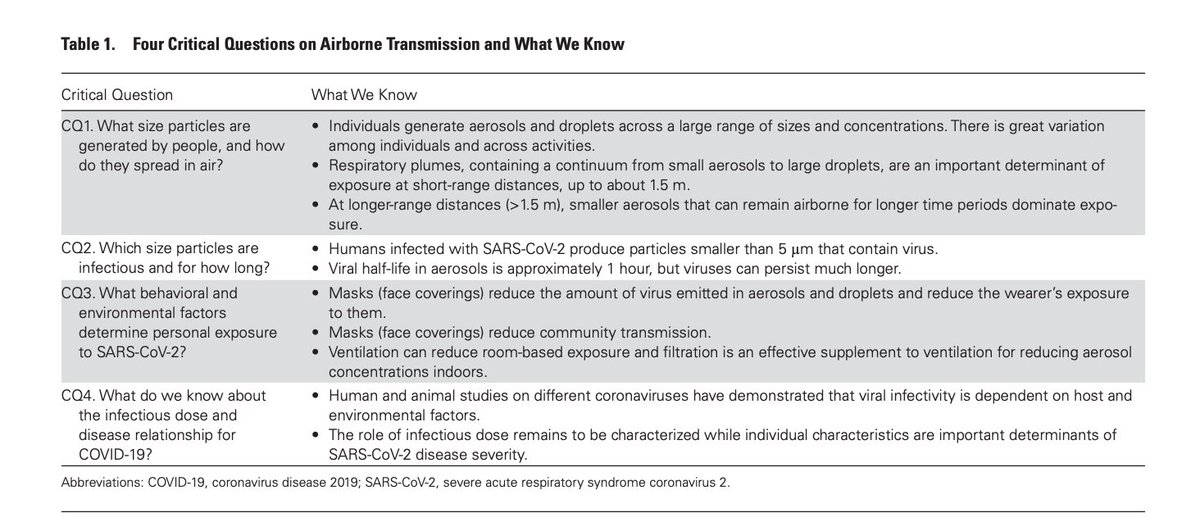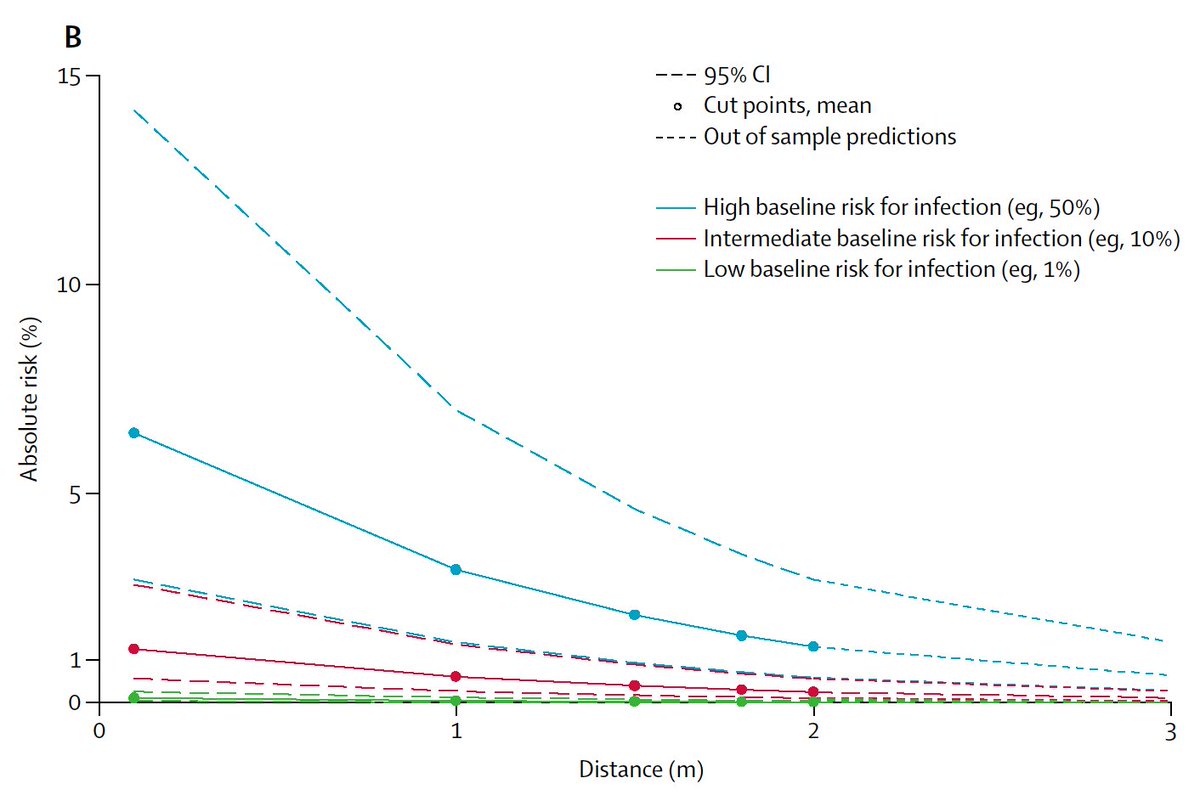
1/ Airborne transmission, and the 3 feet vs. 6 feet question: A 🧵 with links for policy advocates trying to sort through the science...
WARNING: Nuance Ahead
WARNING: Nuance Ahead
2/ COVID-19 is mainly spread by inhaling small particles.
Timeline with illustrations, articles, studies:
#COVIDisAirborne #masks4All #bewareOfSharedAir #ventilation. See: its-airborne.org/covid19-timeli… via @AerosolizedC19
Airborne Transmission FAQ by experts: tinyurl.com/FAQ-aerosols
Timeline with illustrations, articles, studies:
#COVIDisAirborne #masks4All #bewareOfSharedAir #ventilation. See: its-airborne.org/covid19-timeli… via @AerosolizedC19
Airborne Transmission FAQ by experts: tinyurl.com/FAQ-aerosols
3/ In addition, here's Dr. @linseymarr and Dr. @jljcolorado's bibliography regarding "Transmission of COVID-19." They're top experts.
tinyurl.com/p4h9mbzz
"What We Know" 2021 summary: Respiratory plumes/short-range "close" exposure are <1.5 m (4.92 ft)
tinyurl.com/3sbktpzz
tinyurl.com/p4h9mbzz
"What We Know" 2021 summary: Respiratory plumes/short-range "close" exposure are <1.5 m (4.92 ft)
tinyurl.com/3sbktpzz

4/ RESEARCH: A review of 172 studies from 6/20 in The Lancet found distance of 1 m (3.28 ft) reduces infection risk; 2 m (6.56 ft) is better.
Risks of COVID-19 transmission: 82% less at 1 meter apart, then cut in half for each extra meter
tinyurl.com/4xdaydhc
Risks of COVID-19 transmission: 82% less at 1 meter apart, then cut in half for each extra meter
tinyurl.com/4xdaydhc

5/ In same Lancet report, face masks estimated to reduce transmission — pooling results — by about 85%, but better masks (N95s) produced best results (96% reduction); cloth masks (such as students have) were estimated to reduce risks by 67%. (FYI: Eye protection: 78% less risk)
6/ RESEARCH: An analysis on "rebreathed" air found when distancing of 2 m (6.6 ft) is maintained, then TIME spent confined indoors with others, not proximity, dominates exposure risks from aerosol particles.
Close contact <2 m = much more risk
tinyurl.com/58hnfxn8
Close contact <2 m = much more risk
tinyurl.com/58hnfxn8

7/ RESEARCH: Mayo Clinic calculated risks with distance and masks.
Masks were KEY; but watch video (leakage!)
Without masks, risk was 17% at 3 feet, and 3% at 6 feet.
"CDC guidance is good - 6 foot has an important impact on the number of particles."
tinyurl.com/439cmj5p
Masks were KEY; but watch video (leakage!)
Without masks, risk was 17% at 3 feet, and 3% at 6 feet.
"CDC guidance is good - 6 foot has an important impact on the number of particles."
tinyurl.com/439cmj5p

8/ Dr. @nausheenrshah also shared calculations on risk:
Probability:
📌 Scales inversely with VENTILATION; Increasing 3 ACH (air refreshes/hour) ➡️ 6 ACH halves risk.
📌 Linear with TIME; Longer ➡️ more risk.
📌 Reduce DISTANCE to 3 ft ➡️ Risk goes up 4x
Probability:
📌 Scales inversely with VENTILATION; Increasing 3 ACH (air refreshes/hour) ➡️ 6 ACH halves risk.
📌 Linear with TIME; Longer ➡️ more risk.
📌 Reduce DISTANCE to 3 ft ➡️ Risk goes up 4x
https://twitter.com/nausheenrshah/status/1366252525066866689?s=20
9/ RESEARCH: A review of school districts in MA and 3 ft vs. 6 ft standards found: Lower physical distancing policies can be adopted in school settings with masking mandates without negatively impacting student or staff safety.

https://twitter.com/EricTopol/status/1371266606727237635?s=20

10/ Study has critics. Some questioned flaws such a 3 ft district, with 20% attendance, may have 8 ft space. (It's policy, not reality, in data.)
tinyurl.com/4vdfj3v8
tinyurl.com/tvzr438z
Others say 3 ft. OK w/ 💯 mask compliance + ventilation.
tinyurl.com/5meek7da
tinyurl.com/4vdfj3v8
tinyurl.com/tvzr438z
Others say 3 ft. OK w/ 💯 mask compliance + ventilation.
tinyurl.com/5meek7da
11/ More critiques: Confidence interval was so big that 6 ft could actually have reduced cases by as much as 47%.
Others questioned if 3 ft would be a good idea with more transmissible/more severe variants now spreading.
We wrote a 🧵 on variants:
Others questioned if 3 ft would be a good idea with more transmissible/more severe variants now spreading.
We wrote a 🧵 on variants:
https://twitter.com/smartrestartaps/status/1368617167931990018
12/ COMMUNITY SPREAD: For us in @ArlingtonVA, more people in a room = more probability that someone will bring an asymptomatic case of COVID-19.
The risk for a class of 15 is 6%.
But for a class of 25, it's 10%.
For one day x 4-6 classes. (No cohorting)
covid19risk.biosci.gatech.edu
The risk for a class of 15 is 6%.
But for a class of 25, it's 10%.
For one day x 4-6 classes. (No cohorting)
covid19risk.biosci.gatech.edu

13/ The Event Risk Assessment tool assumes 3x undercount. Local data indicates our testing for kids may catch as few as 1 of 17 cases. Asymptomatic "silent transmission" between kids could play a much bigger role than we know in this pandemic.
https://twitter.com/smartrestartaps/status/1372592386627530752?s=20
14/ This thread and article are a good summary of different perspectives on the CDC's changes.
nytimes.com/2021/03/16/hea…
https://twitter.com/HuffmanLabDU/status/1372309665887911936
nytimes.com/2021/03/16/hea…
15/ In VA, 3 ft has always been OK, but APS chose to go half capacity and use 6 ft rule this year.
>30% of APS rooms are below code: lack fresh air for full occupancy. Problem!
@BarbaraKanninen @Monique4APS @PriddyAPS @ReidForSchools @cdiaztorres240 @SuptDuran @BrianStockton19
>30% of APS rooms are below code: lack fresh air for full occupancy. Problem!
@BarbaraKanninen @Monique4APS @PriddyAPS @ReidForSchools @cdiaztorres240 @SuptDuran @BrianStockton19
16/ If APS were to utilize 3 ft distancing, even JUST for little kids, then APS should INCREASE and STRENGTHEN other mitigations, @APSVaSchoolBd.
Here are some ways we can strengthen the plan and support keeping our schools open...
Here are some ways we can strengthen the plan and support keeping our schools open...
https://twitter.com/smartrestartaps/status/1354518152596623365?s=20
17/ CDC has minimum 6 ft distance for eating indoors, but has recommended closing cafeterias.
Eating indoors right now is too risky — at any distance.
Let's go outside and take COVID-19 off the menu.
Make it happen for ALL kids, APS.
smartrestartaps.org/vital-issues/l…
Eating indoors right now is too risky — at any distance.
Let's go outside and take COVID-19 off the menu.
Make it happen for ALL kids, APS.
smartrestartaps.org/vital-issues/l…
18/ APS is being reckless with older kids who are not cohorting as CDC recommended. There's no time for rooms to clear air between classes.
FYI: HEPA air cleaners adding 5.5-5.7 air changes of clean air would clear air and reduce inhalation risks by 6x!
tinyurl.com/ycpzbfre
FYI: HEPA air cleaners adding 5.5-5.7 air changes of clean air would clear air and reduce inhalation risks by 6x!
tinyurl.com/ycpzbfre
19/ APS, you still have rooms that must get 2 HEPA cleaners to hit the goal of 5-6 ACH (air changes per hour) of CLEAN AIR.
Nearly 700 experts have endorsed this standard now:
Don't increase capacity without increasing clean air!
Nearly 700 experts have endorsed this standard now:
https://twitter.com/WBahnfleth/status/1372922215507881992?s=20
Don't increase capacity without increasing clean air!
https://twitter.com/smartrestartaps/status/1366837251179745280?s=20
20/ Universal masking is vital. Let's provide better masks to students and teachers. Just a tiny leak (2% of the surface) can reduce a mask's filtration efficiency by almost 80%.
But better, fitted masks + ventilation (5 ACH goal) combine to reduce risk.
But better, fitted masks + ventilation (5 ACH goal) combine to reduce risk.
https://twitter.com/DavidLKeating/status/1346855545693761539?s=20
21/ Before any school schedule changes, we want APS to explain plans for C19 testing — for kids with/without symptoms.
Is APS ready to contact trace kids sitting within 6 ft? How? Is APS sending emails about possible exposures or confirmed diagnoses?
Is APS ready to contact trace kids sitting within 6 ft? How? Is APS sending emails about possible exposures or confirmed diagnoses?
https://twitter.com/ambilinski/status/1353751984852131841
22/ OK, that's it! Please comment with any key studies on the 3 ft/6 ft question that you've found.
https://twitter.com/VVuorinenAalto/status/1341310299236954112
@threadreaderapp unroll
FYI: Source for leakage stat... h/t to @kprather88 for noting this study recently.
tandfonline.com/doi/full/10.10…
tandfonline.com/doi/full/10.10…
A second excellent link for mask data. We are huge advocates for masking, but masks are best when combined with other strategies. They aren't going to be 100% — especially as used by little kids and with different quality levels.
https://twitter.com/linseymarr/status/1370005674906812416?s=20
23/ ADDITION: Thoughtful perspective on school building reopenings, new variants, and the distance question by @dgurdasani1 and colleagues. Covers all the reasons for concern about relaxing in guidelines at this point in time.
ineteconomics.org/perspectives/b…
ineteconomics.org/perspectives/b…
24/ ADDITION: Dr. Don Milton's take on what schools must do: tinyurl.com/4s5zruem
(Experts' expert on airborne disease)
📌 Increase clean air to 10L/s*person (makes 5.2 air refreshes/hour in avg. APS room)
📌 Contact tracing
📌 Outdoor lunch
📌 Better masks
📌 👋 washing
(Experts' expert on airborne disease)
📌 Increase clean air to 10L/s*person (makes 5.2 air refreshes/hour in avg. APS room)
📌 Contact tracing
📌 Outdoor lunch
📌 Better masks
📌 👋 washing
• • •
Missing some Tweet in this thread? You can try to
force a refresh


